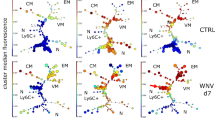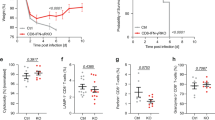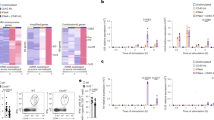Abstract
The recognition of microbial patterns by Toll-like receptors (TLRs) is critical for activation of the innate immune system. Although TLRs are expressed by human CD4+ T cells, their function is not well understood. Here we found that engagement of TLR7 in CD4+ T cells induced intracellular calcium flux with activation of an anergic gene-expression program dependent on the transcription factor NFATc2, as well as unresponsiveness of T cells. As chronic infection with RNA viruses such as human immunodeficiency virus type 1 (HIV-1) induces profound dysfunction of CD4+ T cells, we investigated the role of TLR7-induced anergy in HIV-1 infection. Silencing of TLR7 markedly decreased the frequency of HIV-1-infected CD4+ T cells and restored the responsiveness of those HIV-1+ CD4+ T cells. Our results elucidate a previously unknown function for microbial pattern–recognition receptors in the downregulation of immune responses.
This is a preview of subscription content, access via your institution
Access options
Subscribe to this journal
Receive 12 print issues and online access
$209.00 per year
only $17.42 per issue
Buy this article
- Purchase on Springer Link
- Instant access to full article PDF
Prices may be subject to local taxes which are calculated during checkout








Similar content being viewed by others
References
Song, D.H. & Lee, J.O. Sensing of microbial molecular patterns by Toll-like receptors. Immunol. Rev. 250, 216–229 (2012).
Diebold, S.S., Kaisho, T., Hemmi, H., Akira, S. & Reis e Sousa, C. Innate antiviral responses by means of TLR7-mediated recognition of single-stranded RNA. Science 303, 1529–1531 (2004).
Heil, F. et al. Species-specific recognition of single-stranded RNA via toll-like receptor 7 and 8. Science 303, 1526–1529 (2004).
Kugelberg, E. Innate immunity: Making mice more human the TLR8 way. Nat. Rev. Immunol. 14, 6 (2014).
Kawai, T. & Akira, S. Innate immune recognition of viral infection. Nat. Immunol. 7, 131–137 (2006).
Kabelitz, D. Expression and function of Toll-like receptors in T lymphocytes. Curr. Opin. Immunol. 19, 39–45 (2007).
Gelman, A.E., Zhang, J., Choi, Y. & Turka, L.A. Toll-like receptor ligands directly promote activated CD4+ T cell survival. J. Immunol. 172, 6065–6073 (2004).
Caron, G. et al. Direct stimulation of human T cells via TLR5 and TLR7/8: flagellin and R-848 up-regulate proliferation and IFN-gamma production by memory CD4+ T cells. J. Immunol. 175, 1551–1557 (2005).
Grakoui, A. et al. HCV persistence and immune evasion in the absence of memory T cell help. Science 302, 659–662 (2003).
Lechner, F. et al. Analysis of successful immune responses in persons infected with hepatitis C virus. J. Exp. Med. 191, 1499–1512 (2000).
Walker, B. & McMichael, A. The T-cell response to HIV. Cold Spring Harb. Perspect. Med. 2, a007054 (2012).
Chamberlain, N.D. et al. Ligation of TLR7 by rheumatoid arthritis synovial fluid single strand RNA induces transcription of TNFα in monocytes. Ann. Rheum. Dis. 72, 418–426 (2013).
Cros, J. et al. Human CD14dim monocytes patrol and sense nucleic acids and viruses via TLR7 and TLR8 receptors. Immunity 33, 375–386 (2010).
Dzopalic, T. et al. Loxoribine, a selective Toll-like receptor 7 agonist, induces maturation of human monocyte-derived dendritic cells and stimulates their Th-1- and Th-17-polarizing capability. Int. Immunopharmacol. 10, 1428–1433 (2010).
Chappert, P. & Schwartz, R.H. Induction of T cell anergy: integration of environmental cues and infectious tolerance. Curr. Opin. Immunol. 22, 552–559 (2010).
Quill, H. & Schwartz, R.H. Stimulation of normal inducer T cell clones with antigen presented by purified Ia molecules in planar lipid membranes: specific induction of a long-lived state of proliferative nonresponsiveness. J. Immunol. 138, 3704–3712 (1987).
Macián, F. et al. Transcriptional mechanisms underlying lymphocyte tolerance. Cell 109, 719–731 (2002).
Lenert, P.S. Classification, mechanisms of action, and therapeutic applications of inhibitory oligonucleotides for Toll-like receptors (TLR) 7 and 9. Mediators Inflamm. 2010, 986596 (2010).
Schwartz, R.H. Models of T cell anergy: is there a common molecular mechanism? J. Exp. Med. 184, 1–8 (1996).
Luo, C. et al. Recombinant NFAT1 (NFATp) is regulated by calcineurin in T cells and mediates transcription of several cytokine genes. Mol. Cell. Biol. 16, 3955–3966 (1996).
Luo, C. et al. Interaction of calcineurin with a domain of the transcription factor NFAT1 that controls nuclear import. Proc. Natl. Acad. Sci. USA 93, 8907–8912 (1996).
Okamura, H. et al. Concerted dephosphorylation of the transcription factor NFAT1 induces a conformational switch that regulates transcriptional activity. Mol. Cell 6, 539–550 (2000).
Gao, B., Kong, Q., Kemp, K., Zhao, Y.S. & Fang, D. Analysis of sirtuin 1 expression reveals a molecular explanation of IL-2-mediated reversal of T-cell tolerance. Proc. Natl. Acad. Sci. USA 109, 899–904 (2012).
Heissmeyer, V. et al. Calcineurin imposes T cell unresponsiveness through targeted proteolysis of signaling proteins. Nat. Immunol. 5, 255–265 (2004).
Jeon, M.S. et al. Essential role of the E3 ubiquitin ligase Cbl-b in T cell anergy induction. Immunity 21, 167–177 (2004).
Zha, Y. et al. T cell anergy is reversed by active Ras and is regulated by diacylglycerol kinase-alpha. Nat. Immunol. 7, 1166–1173 (2006).
Safford, M. et al. Egr-2 and Egr-3 are negative regulators of T cell activation. Nat. Immunol. 6, 472–480 (2005).
Castellanos, M.C. et al. Expression of the leukocyte early activation antigen CD69 is regulated by the transcription factor AP-1. J. Immunol. 159, 5463–5473 (1997).
Kim, J.O., Kim, H.W., Baek, K.M. & Kang, C.Y. NF-kappaB and AP-1 regulate activation-dependent CD137 (4–1BB) expression in T cells. FEBS Lett. 541, 163–170 (2003).
Miedema, F. Immunological abnormalities in the natural history of HIV infection: mechanisms and clinical relevance. Immunodefic. Rev. 3, 173–193 (1992).
Faith, A., O'Hehir, R.E., Malkovsky, M. & Lamb, J.R. Analysis of the basis of resistance and susceptibility of CD4+ T cells to human immunodeficiency virus (HIV)-gp120 induced anergy. Immunology 76, 177–184 (1992).
Cayota, A., Vuillier, F., Gonzalez, G. & Dighiero, G. In vitro antioxidant treatment recovers proliferative responses of anergic CD4+ lymphocytes from human immunodeficiency virus-infected individuals. Blood 87, 4746–4753 (1996).
Maggi, E. et al. Reduced production of interleukin 2 and interferon-γ and enhanced helper activity for IgG synthesis by cloned CD4+ T cells from patients with AIDS. Eur. J. Immunol. 17, 1685–1690 (1987).
Chen, H. et al. CD4+ T cells from elite controllers resist HIV-1 infection by selective upregulation of p21. J. Clin. Invest. 121, 1549–1560 (2011).
Yamamoto, T. et al. Selective transmission of R5 HIV-1 over X4 HIV-1 at the dendritic cell-T cell infectious synapse is determined by the T cell activation state. PLoS Pathog. 5, e1000279 (2009).
Bigby, M., Wang, P., Fierro, J.F. & Sy, M.S. Phorbol myristate acetate-induced down-modulation of CD4 is dependent on calmodulin and intracellular calcium. J. Immunol. 144, 3111–3116 (1990).
Cloyd, M.W., Lynn, W.S., Ramsey, K. & Baron, S. Inhibition of human immunodeficiency virus (HIV-1) infection by diphenylhydantoin (dilantin) implicates role of cellular calcium in virus life cycle. Virology 173, 581–590 (1989).
Aramburu, J. et al. Affinity-driven peptide selection of an NFAT inhibitor more selective than cyclosporin A. Science 285, 2129–2133 (1999).
Kinoshita, S. et al. The T cell activation factor NF-ATc positively regulates HIV-1 replication and gene expression in T cells. Immunity 6, 235–244 (1997).
Crellin, N.K. et al. Human CD4+ T cells express TLR5 and its ligand flagellin enhances the suppressive capacity and expression of FOXP3 in CD4+CD25+ T regulatory cells. J. Immunol. 175, 8051–8059 (2005).
Monroe, K.M. et al. IFI16 DNA sensor is required for death of lymphoid CD4 T cells abortively infected with HIV. Science 343, 428–432 (2014).
Yan, N., Regalado-Magdos, A.D., Stiggelbout, B., Lee-Kirsch, M.A. & Lieberman, J. The cytosolic exonuclease TREX1 inhibits the innate immune response to human immunodeficiency virus type 1. Nat. Immunol. 11, 1005–1013 (2010).
Gringhuis, S.I. et al. HIV-1 exploits innate signaling by TLR8 and DC-SIGN for productive infection of dendritic cells. Nat. Immunol. 11, 419–426 (2010).
de la Casa-Esperón, E. Horizontal transfer and the evolution of host-pathogen interactions. Int. J. Evol. Biol. 2012, 679045 (2012).
Balada, E., Vilardell-Tarres, M. & Ordi-Ros, J. Implication of human endogenous retroviruses in the development of autoimmune diseases. Int. Rev. Immunol. 29, 351–370 (2010).
Pawar, R.D. et al. Inhibition of Toll-like receptor-7 (TLR-7) or TLR-7 plus TLR-9 attenuates glomerulonephritis and lung injury in experimental lupus. J. Am. Soc. Nephrol. 18, 1721–1731 (2007).
Gibellini, D., Vitone, F., Schiavone, P., Ponti, C., La Placa, M. & Re, M.C. Quantitative detection of human immunodeficiency virus type 1 (HIV-1) proviral DNA in peripheral blood mononuclear cells by SYBR green real-time PCR technique. J. Clin. Virol. 29, 282–289 (2004).
Acknowledgements
We thank L. Devine and Z. Wang for technical assistance; Y. Tsunetsugu-Yokota (Tokyo University of Technology) for HIV-1NL-D proviral DNA; D. Bruce, H. Zapata and B.C. Herold and the laboratory of B.C. Herold for the recruitment of patients; and R. Medzhitov, A. Iwasaki and members of the Hafler laboratory for comments and suggestions. Supported by the National MS Society (CA1061-A-18), the US National Institutes of Health (P01 AI045757, U19 AI046130, U19 AI070352 and P01 AI039671 to D.A.H., and R01 AI065309 to M.J.K.), the Penates Foundation (D.A.H.), the Nancy Taylor Foundation for Chronic Diseases (D.A.H.) and the Race to Erase MS Foundation (M.D.-V.).
Author information
Authors and Affiliations
Contributions
M.D.-V. designed and performed the experiments, analyzed data and wrote the manuscript; A.-S.G. and M.d.M. performed experiments; M.J.K. provided HIV-1 samples; and D.A.H. assisted with the design of experiments, supervised the project and wrote the manuscript.
Corresponding authors
Ethics declarations
Competing interests
The authors declare no competing financial interests.
Integrated supplementary information
Supplementary Figure 1 Costimulatory effects of TLR ligands on CD4+ T cells.
CFSE-labeled CD4+ T cells were stimulated with anti-CD3 and anti-CD28 in the presence of different TLR ligands. a. Histograms show the frequency of viable proliferating CD4+ T cells (numbers in histograms). b. Statistical analysis showing the frequency of proliferating CD4+ T cells of 5 experiments performed with 1 donor each. c. IFN-γ and d IL-2 ELISA measurement after 3 days of stimulation. e. CD4+ T cells were stimulated with anti-CD3 and anti-CD28 in the presence of IMQ or vehicle as control, RNA was isolated after 12 hours and subjected to gene expression analysis by TaqMan real-time PCR (n=3 donors in 3 independent experiments). *p < 0.05, **p < 0.005, ***p < 0.0005. Error bars represent mean±s.e.m.
Supplementary Figure 2 Imiquimod inhibits the activation of T cell clones.
16 T cell clones were grown from a single donor for 18 days and restimulated with anti-CD3 and anti-CD28 in the presence or absence of IMQ for 3 days. a. IFN-γ secretion measured by ELISA at day 3 after activation. b. CD25 gene expression at day 3 after activation. *p < 0.05, **p < 0.005, ***p < 0.0005.
Supplementary Figure 3 Monocytes are activated with TLR7 ligands.
CD14+ monocytes were stimulated with 5 μg/ml IMQ or vehicle (Veh) for 24 hours. a. Surface staining of HLA-DR, CD80, CD86 and CD25 on imiquimod- (black) or vehicle-treated monocytes (dashed) as compared to isotype control (gray curve). b. IL-1β, TNFα, IL-6 and IL-10 cytokine secretion as measured by ELISA (n=5 in 5 independent experiments). *p < 0.05. Error bars represent mean±s.e.m.
Supplementary Figure 4 Imiquimod induces an increase in intracellular calcium concentration.
a. Bound/unbound calcium ratio on CD4+ T cells stimulated with different doses of IMQ, ssRNA40 (negative control) or ionomycin (positive control) of 6 independent experiments performed. b. Dot plots represent calcium fluxes as measured by INDO-1AM ratio over time on CD4+ T cells stimulated with Poly(I:C) (TLR3 ligand, left) or ODN2006 (TLR9 ligand, right). Representative example of 5 independent experiments performed with one donor each.
Supplementary Figure 5 Expression of anergy-related genes in CD4+ T cells treated with ionomycin or with PMA plus ionomycin.
Gene expression of anergy-related genes on CD4+ T cells treated for 16 hours with Ionomycin (Iono), PMA and ionomycin (P+I) or vehicle. (n=6 donors in 6 independent experiments). *p < 0.05, **p < 0.005, ***p < 0.0005. Error bars represent mean±s.e.m.
Supplementary Figure 6 Imiquimod fails to upregulate anergy-related genes in CD4+ T cells in which the gene encoding NFATc2 is silenced.
CD4+ T cells were transduced with shRNA specific for NFAT1 or a non-target control. a. Transduced cells were stimulated with anti-CD3 and anti-CD28 in the presence or absence of IMQ. Bars diagram shows Nfat1 gene expression by TaqMan real-time PCR 24 hours after stimulation. b. Anergy-related gene expression was analyzed on resting NFAT1- or non-target-transduced cells after IMQ treatment for 2 hours, by TaqMan real-time PCR. (n=3 donors in 3 independent experiments). *p < 0.05, **p < 0.005. Error bars represent mean±s.e.m.
Supplementary Figure 7 In vitro infection with HIV-1 induces anergy in CD4+ T cells.
CD4+ T cells were stimulated with anti-CD3 and anti-CD28 for two days and subsequently infected with HIV-1NL-D. a. Frequency of viable HIV-1NL-D+ CD4+ T cells measured every 48 hours for a total of 11 days (n=3 donors in 3 independent experiments). b. Representative example of IL-2 and IFN-γ secretion as measured by intracellular staining after a 4 hour PMA/Ionomycin stimulation at day 7 after infection on mock infected cells (left panel), total CD4+ T cells infected with HIV-1NL-D (middle panel) or HIV-1NL-D+ cells. c. Statistical analysis of IL-2 and IFN-γ (n=3 donors in 3 independent experiments). Error bars represent mean±s.e.m. *p < 0.05, **p < 0.005.
Supplementary Figure 8 Apoptosis after infection of TLR7-deficient cells with HIV-1NL-D.
CD4+ T cells were stimulated with anti-CD3 and anti-CD28 in the presence of two TLR7 shRNA (clones 3 and 4) or non-target control shRNA (NT). After two days, the cells were infected with HIV-1NL-D and stained with Annexin V and 7-AAD every 24 hours for 11 days. n=6 donors in 6 independent experiments. Error bars represent mean±s.e.m.
Supplementary information
Supplementary Text and Figures
Supplementary Figures 1–8 and Supplementary Table 1 (PDF 1425 kb)
Rights and permissions
About this article
Cite this article
Dominguez-Villar, M., Gautron, AS., de Marcken, M. et al. TLR7 induces anergy in human CD4+ T cells. Nat Immunol 16, 118–128 (2015). https://doi.org/10.1038/ni.3036
Received:
Accepted:
Published:
Issue Date:
DOI: https://doi.org/10.1038/ni.3036
This article is cited by
-
TLR8 escapes X chromosome inactivation in human monocytes and CD4+ T cells
Biology of Sex Differences (2023)
-
NFATc2-dependent epigenetic upregulation of CXCL14 is involved in the development of neuropathic pain induced by paclitaxel
Journal of Neuroinflammation (2020)
-
Escape from X chromosome inactivation and female bias of autoimmune diseases
Molecular Medicine (2020)
-
Sensing of HIV-1 by TLR8 activates human T cells and reverses latency
Nature Communications (2020)
-
Toll-like receptors in lupus nephritis
Journal of Biomedical Science (2018)



